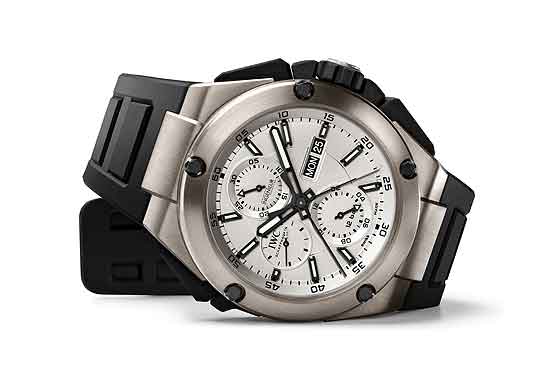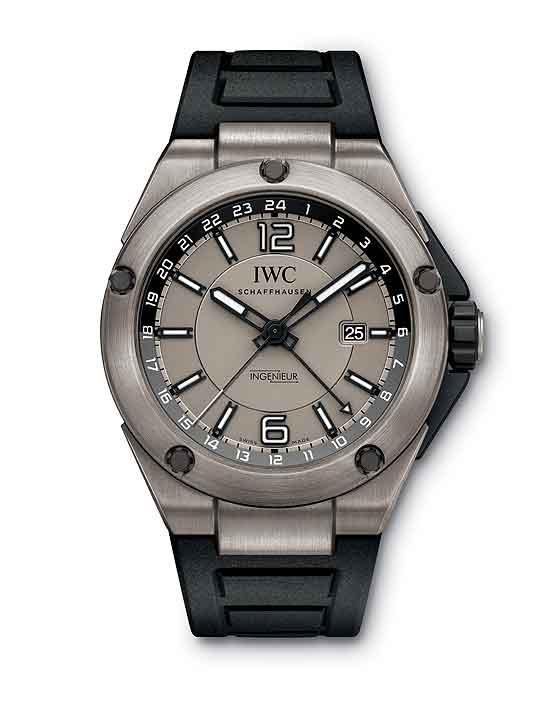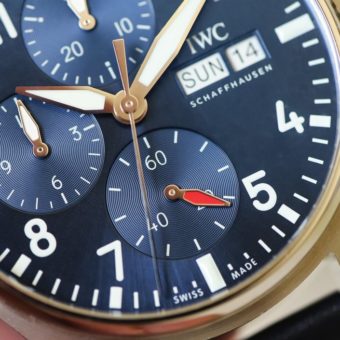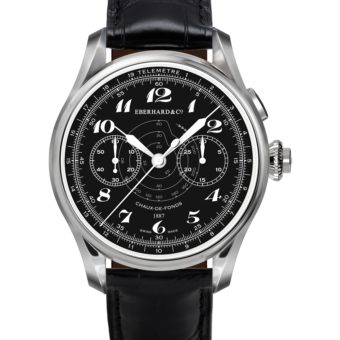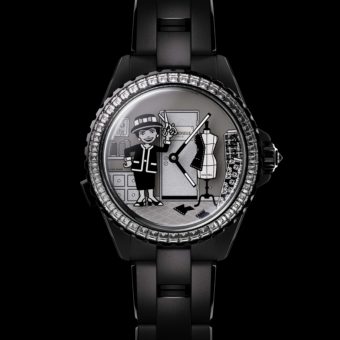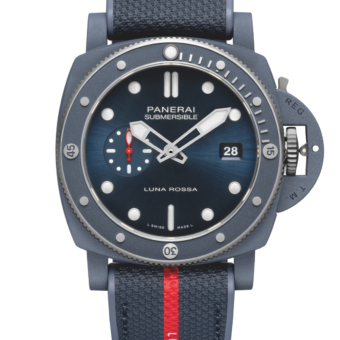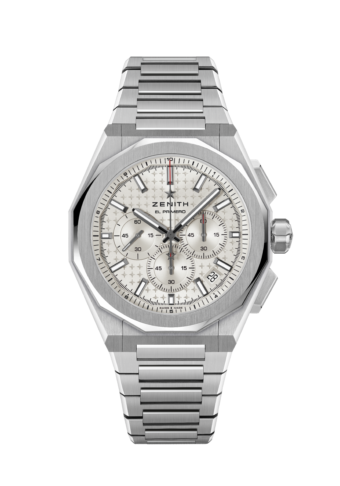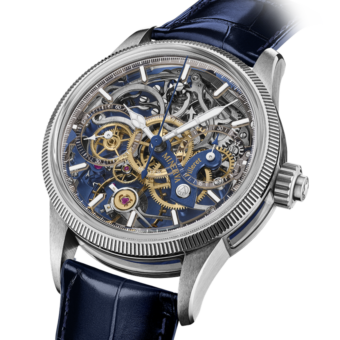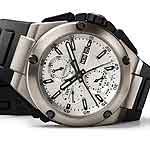 For the new timepieces in its re-tooled Ingenieur collection, IWC Shaffhausen wanted a direct connection to Formula One auto racing, in both the watches’ design and in the materials used to make them. Hence the use of carbon fiber, high-tech ceramics, and, for two of its new models, titanium.
For the new timepieces in its re-tooled Ingenieur collection, IWC Shaffhausen wanted a direct connection to Formula One auto racing, in both the watches’ design and in the materials used to make them. Hence the use of carbon fiber, high-tech ceramics, and, for two of its new models, titanium.
Like all of the new IWC Ingenieur watches, launched at this year’s SIHH watch fair in Geneva, the design and construction of the Ingenieur Double Chronograph Titanium and Ingenieur Dual Time Titanium are influenced by IWC’s partnership with the Mercedes AMG Petronas Formula One racing team. The distinctive bezels feature five screws, instead of the more traditional bores, which secure the bezels firmly to the titanium cases. IWC was among the first to introduce titanium to the watch industry in the early 1980s, recognizing the same properties that make it popular in the automobile industry: lightness (half the weight of stainless steel), resistance to corrosion and magnetism, and comfort on skin. In both watches, titanium is used for not only the case, including bezel, but for the crown, crown protector, and push-buttons, all of which are then coated with rubber for a better grip.
Both watches also have complications that IWC chose for their usefulness in Formula One auto racing. The IWC Ingenieur Double Chronograph Titanium ($12,700) features a chronograph mechanism with a split-seconds hand that can be used to record two intermediate times within a given minute while the blue- or white-tipped chronograph hand continues to run. When the push-button at 10 o’clock is pressed again, the split-seconds hand instantly catches up with the chronograph hand and runs synchronously with it again. As a result, the user can record as many lap times — important for determining pole position in an automobile race — as he chooses. The subdial at 12 o’clock tallies up to 30 chronograph minutes with a triangle-tipped jumping minute-counter hand, which makes two revolutions every hour. The hours subdial at “6 o’clock” records stop times in half-hour increments. The subdials are recessed into the dial, lending it an instrument-inspired look. Windows for the day and date appear at 3 o’clock. The 45-mm case of the Ingenieur Double Chronograph Titanium is water-resistant to 120 meters and features a screw-down crown; it comes on a rubber strap and is available with either a silver-plated or black dial. The automatic movement, IWC Caliber 79420, has 29 jewels, a frequency of 28,800 vph, and a 44-hour power reserve.
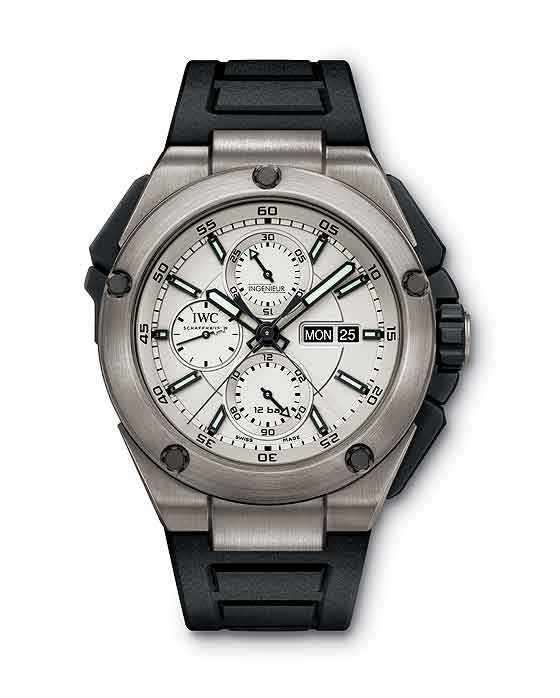 The GMT function in the IWC Ingenieur Dual Time Titanium ($8,800) is also meant to serve the needs of Formula One drivers, who spend much of the year shuttling to numerous international cities on the racing circuit and often need to keep track of the time in more than one time zone at once. The main dial displays the current local time by means of traditional center-mounted hands that be advanced or moved back in one-hour steps, even beyond the International Date Line. The other center-mounted hands are the the seconds hand, which has a white tip, and a white-triangle-tipped pointer that points to the outer 24-hour ring to indicate the time in a second time zone. IWC’s designers also made the upper half of the ring, displaying 6 PM to 6:00 AM, darker than the lower half in order for the wearer to more easily differentiate between day and night. The dial, which is titanium-colored to echo the 45-mm case, also has a date display at 3 o’clock. The watch contains IWC automatic Caliber 35720, which has a 42-hour power reserve. The watch comes on a black rubber strap with titanium pin buckle.
The GMT function in the IWC Ingenieur Dual Time Titanium ($8,800) is also meant to serve the needs of Formula One drivers, who spend much of the year shuttling to numerous international cities on the racing circuit and often need to keep track of the time in more than one time zone at once. The main dial displays the current local time by means of traditional center-mounted hands that be advanced or moved back in one-hour steps, even beyond the International Date Line. The other center-mounted hands are the the seconds hand, which has a white tip, and a white-triangle-tipped pointer that points to the outer 24-hour ring to indicate the time in a second time zone. IWC’s designers also made the upper half of the ring, displaying 6 PM to 6:00 AM, darker than the lower half in order for the wearer to more easily differentiate between day and night. The dial, which is titanium-colored to echo the 45-mm case, also has a date display at 3 o’clock. The watch contains IWC automatic Caliber 35720, which has a 42-hour power reserve. The watch comes on a black rubber strap with titanium pin buckle.
Click here for more info on IWC’s new Ingenieur collection and its partnership with Mercedes AMG Petronas, from our interview with IWC North America president Gianfranco d’Attis; click here for wallpaper images of the new Ingenieur collection.

